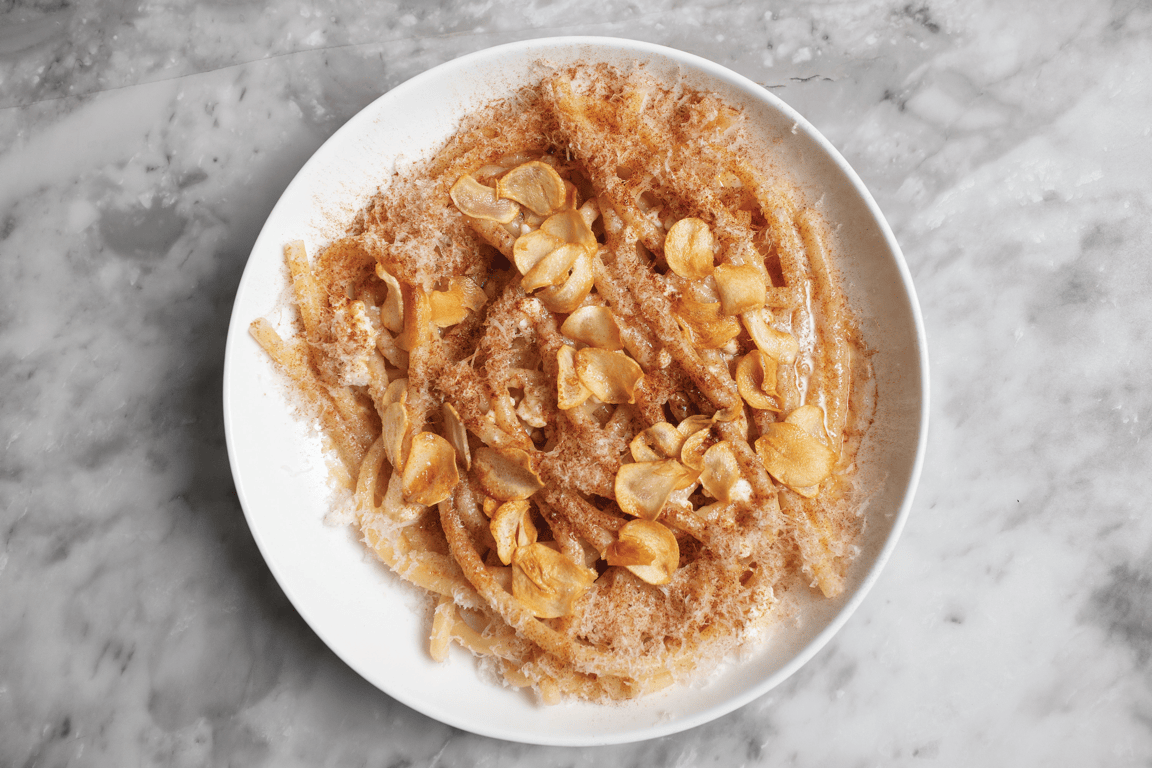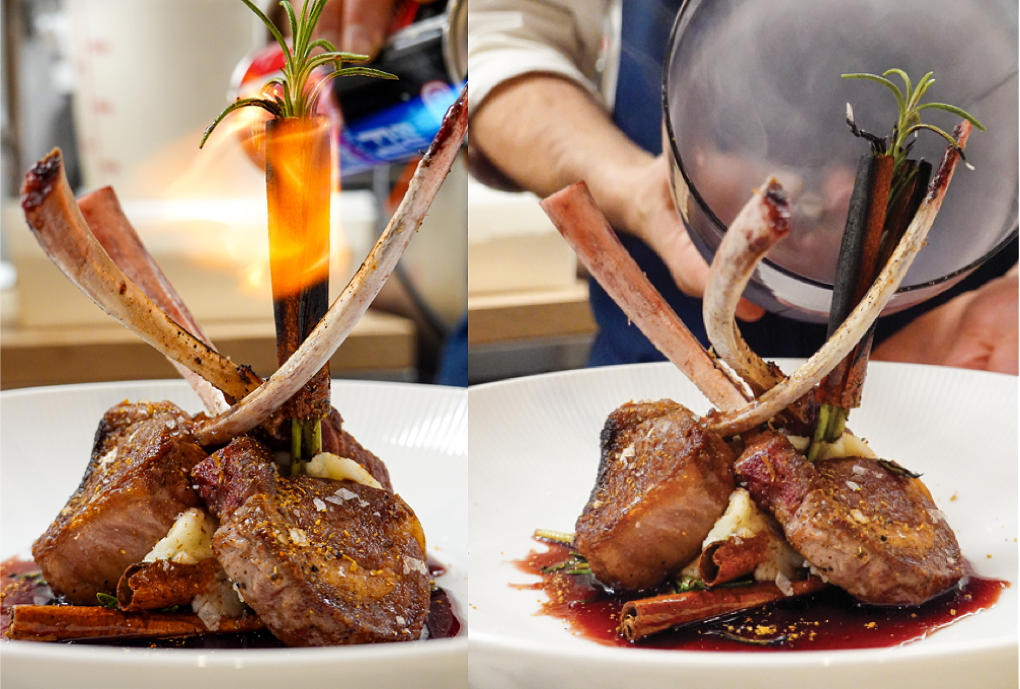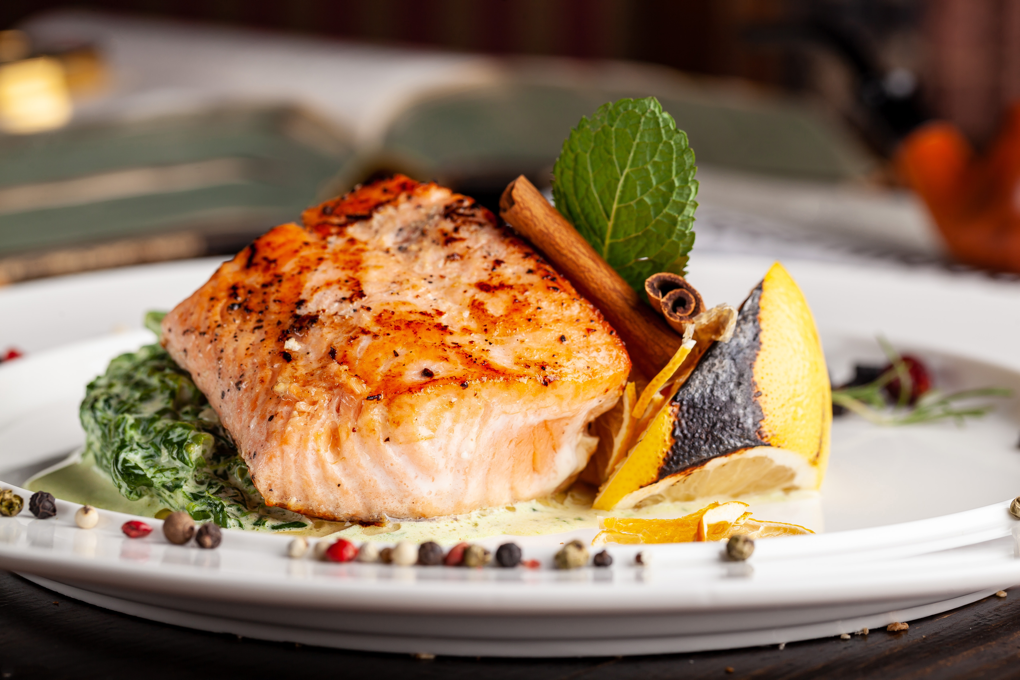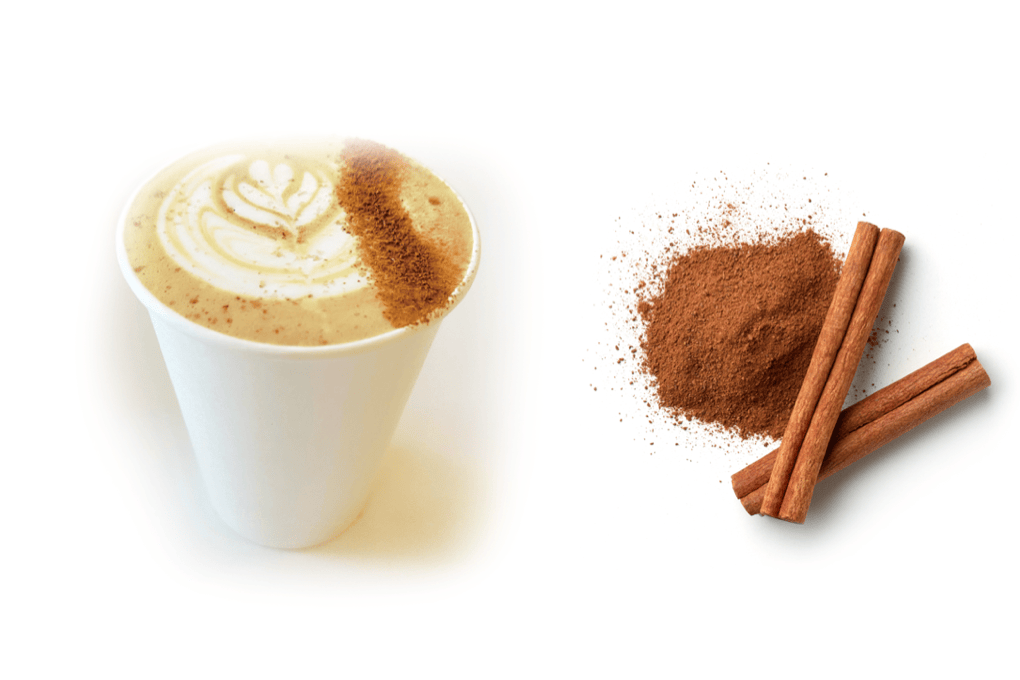
Cinnamon Surprises
The most comforting spice shows off big flavor moves
Cinnamon Surprises
The most comforting spice shows off big flavor moves
By Katie Ayoub
February 7, 2024
By Katie Ayoub
February 7, 2024
Cinnamon reigns as the champion of coziness, the wizard of warmth, the nexus of nostalgia. These superpowers have cemented its position as a trusted favorite in American menu development around desserts, sweet snacks and beverages. But cinnamon’s familiarity has largely kept it boxed into classic, expected builds in this country. Global flavor systems like Vietnamese pho, Middle Eastern shawarma, Indian garam masala and Mexican mole—to name only a few—prove cinnamon’s flavor-building potential. And thanks to continued exploration of world cuisines, enthusiasm around unexpected applications of cinnamon is on the rise.
Today, this warm, sweet, woodsy and slightly piquant spice is stepping out of its traditional bounds and demonstrating its flavor-building prowess in both food and beverage as an unexpected accent, tableside flourish, flavor bridge and premium marker. Today’s foodservice landscape showcases plenty of modern opportunity with cinnamon. Kieran Fleming, executive chef of Agua Caliente Casino in Palm Springs, Calif., pairs his Apple Sausage Salad with a cinnamon vinaigrette. The build boasts mixed greens, Bartlett pears and dried sweet cherries, introducing homey comfort and nuanced flavor with “croutons” of toasted cinnamon-raisin bread. Lovesong Coffee, an eclectic coffee shop in San Diego, offers up The Bees Knees, with espresso, milk, honey and vanilla, then adds a striking raft of smoked salt and cinnamon to finish the profile. This surprising duo is both alluring and memorable, offering a welcome alternative to the beloved pumpkin spice latte. At Luce, an Italian restaurant in Portland, Ore., the antipasti sees an unexpected but delightful accompaniment of pickled mushrooms that feature cinnamon in the brine.
“Cinnamon is the ‘permission ingredient,’ serving as a bridge to a dish or drink that might otherwise be too risky to try,” says Mindy Armstrong, VP of menu innovation at Ascent Hospitality Management. “For operators today, cinnamon could easily be an entry point to using ingredients that are just not as well known. On the flip side, cinnamon can serve as the ‘Wow!’ factor, intentionally showing up in unexpected combinations on the menu.”
 Photo Credit: Rebecca Nottonson
Photo Credit: Rebecca Nottonson Equal Measure in Boston serves lamb chops seasoned with cinnamon, thyme, rosemary, black pepper, allspice and salt, made more dramatic with the tableside flourish of a cloche filled with smoke from a burning cinnamon stick and rosemary twig.
On the World Stage
Cinnamon’s place in world cuisines is long established. As American consumers continue to delight in global flavor profiles, their exposure to cinnamon in savory applications—and their subsequent love for it—deepens. “On a global scale, the cultural significance of cinnamon extends beyond its sweet and comforting connotations to encompass a realm of savory and healthful applications,” says Rosalyn Darling, chef/founder of Darling Culinary. Indeed, cinnamon’s natural link to health and wellness is a supporting driver here, offering consumers an easy-to-love, feel-good ingredient. “The incorporation of cinnamon into savory broths, sauces, rubs and beverages harnesses its innate health benefits, which include its remarkable anti-inflammatory, antioxidant, antiviral, antibacterial and antifungal properties—an impressive assortment of wellness attributes encapsulated within this spice. It exemplifies the adage that health and indulgence can coexist harmoniously.”
Cinnamon deepens flavor, empowering menu developers with complexity cloaked in nostalgia. The spice adds to the specialness of Lula Café’s signature pasta. The Pasta Yiayia, inspired by co-founder Amalea Tshilds’s Greek grandmother, features the salty tang of feta, toasty notes of roasted garlic, nutty tones of brown butter and then the unexpected warmth of cinnamon.
Cinnamon also plays a starring role in a pasta dish at The National in Telluride, Colo. The Spinach Campanelle features a lamb Bolognese with a Turkish shawarma spice blend: cinnamon, garlic, coriander, green cardamom, cayenne, smoked paprika, black pepper and lemon juice. “The foremost flavors in the Bolognese are green cardamom and cinnamon,” says Chris Thompson, executive chef. “Typical in the roasted meats of the Eastern Mediterranean, you’ll see shawarma spices represented in most countries in this part of the world.” Although shawarma has gained traction on American menus in recent years, leveraging its cinnamon-laced flavor profile in unexpected places, like pasta dishes, is a modern approach with broad appeal.
Cinnamon sticks are called on for their theatrical talent in both food and beverage development. At Equal Measure, a modern bar in Boston that’s part of ES Hospitality, a shareable of seared lamb lollipops gets a dramatic upgrade by being served under a small cloche filled with smoke from a burning twig of rosemary and a stick of cinnamon. “Guests are familiar with cinnamon, but when the bark is charred, different oils are accentuated, making the flavor and aroma hit different,” says Nemo Bolin, culinary director of ES Hospitality. The chops are spiced with a savory mixture of cinnamon, thyme, rosemary, black pepper, allspice and salt, and served with a red wine jus.

Whole cinnamon sticks are called on for the theatrical advantage they provide in both food and beverage development. They also serve as a flavor cue. Here, they visually reinforce the specialness of the spice rub on the salmon—a unique blend of cinnamon sugar, black pepper and chile powder.
New Beverage Opportunities
Cinnamon is no stranger to beverage development, but, today, the opportunity is in the unexpected. Sound, a retail beverage brand, illustrates how well it works as an evocative flavor in a refreshing sparkling water starring blueberry, cinnamon and hibiscus. Boston’s Clover Food Lab successfully transplants cinnamon from fall to summer by running a seasonal Cinnamon Lemonade.
Cinnamon also lends drama is to the be space, with impactful flourishes served up by the artful interplay of smoke and aroma. “A burning cinnamon stick adds a big impact to cocktails,” says Kathy Casey, owner, chef and mixologist, Kathy Casey Food Studios-Liquid Kitchen. “Smoke your cocktail glass over a burning cinnamon stick to serve a split-spirit Old Fashioned with bourbon and dark rum, or tuck a smoldering cinnamon stick into a smoky mezcal and tequila cocktail.”

The Bees Knees, served at Lovesong Coffee in San Diego, combines honey, vanilla, espresso and milk; topped with an intriguing duo of smoked salt and cinnamon.
The Mexican Zombie at Zuma Restaurant at the Cosmopolitan Hotel in Las Vegas plays up cinnamon’s dramatic side, garnishing the drink with fresh mint, passionfruit and a smoking cinnamon stick. “Smoky cinnamon is a great play for bartenders,” says Mike Kostyo, VP of Menu Matters consultancy. “Also, grinding sticks in house will bring out cinnamon’s spiciness. At a time when consumers love heat, it’s a great way to approach that flavor profile in an original way. I think using cinnamon for that spicy profile as opposed to its traditional warming profile could be a really interesting approach for beverage developers—and chefs.”
Apothecary-esque bar Polite Provisions in San Diego includes a signature spin to its bestselling Tiki-inspired michelada: Negra Modelo is mixed with spicy cinnamon syrup, pineapple and lime juice, then rimmed with Tajín. The spicy appeal of cinnamon, drawing nostalgic connections with both Red Hots candy and Fireball whiskey, can lead to an exciting pathway for flavor pairing. Consider that hot honey still provides fertile ground for menu play, and that we’re already seeing new iterations of heat and sweet, like spicy maple. Dialing up cinnamon’s spicy side, then pairing it with a sweetener, offers up another promising avenue of innovation.
Cinnamon reigns as the champion of coziness, the wizard of warmth, the nexus of nostalgia. These superpowers have cemented its position as a trusted favorite in American menu development around desserts, sweet snacks and beverages. But cinnamon’s familiarity has largely kept it boxed into classic, expected builds in this country. Global flavor systems like Vietnamese pho, Middle Eastern shawarma, Indian garam masala and Mexican mole—to name only a few—prove cinnamon’s flavor-building potential. And thanks to continued exploration of world cuisines, enthusiasm around unexpected applications of cinnamon is on the rise.
Today, this warm, sweet, woodsy and slightly piquant spice is stepping out of its traditional bounds and demonstrating its flavor-building prowess in both food and beverage as an unexpected accent, tableside flourish, flavor bridge and premium marker. Today’s foodservice landscape showcases plenty of modern opportunity with cinnamon. Kieran Fleming, executive chef of Agua Caliente Casino in Palm Springs, Calif., pairs his Apple Sausage Salad with a cinnamon vinaigrette. The build boasts mixed greens, Bartlett pears and dried sweet cherries, introducing homey comfort and nuanced flavor with “croutons” of toasted cinnamon-raisin bread. Lovesong Coffee, an eclectic coffee shop in San Diego, offers up The Bees Knees, with espresso, milk, honey and vanilla, then adds a striking raft of smoked salt and cinnamon to finish the profile. This surprising duo is both alluring and memorable, offering a welcome alternative to the beloved pumpkin spice latte. At Luce, an Italian restaurant in Portland, Ore., the antipasti sees an unexpected but delightful accompaniment of pickled mushrooms that feature cinnamon in the brine.
“Cinnamon is the ‘permission ingredient,’ serving as a bridge to a dish or drink that might otherwise be too risky to try,” says Mindy Armstrong, VP of menu innovation at Ascent Hospitality Management. “For operators today, cinnamon could easily be an entry point to using ingredients that are just not as well known. On the flip side, cinnamon can serve as the ‘Wow!’ factor, intentionally showing up in unexpected combinations on the menu.”
 Photo Credit: Rebecca Nottonson
Photo Credit: Rebecca Nottonson Equal Measure in Boston serves lamb chops seasoned with cinnamon, thyme, rosemary, black pepper, allspice and salt, made more dramatic with the tableside flourish of a cloche filled with smoke from a burning cinnamon stick and rosemary twig.
On the World Stage
Cinnamon’s place in world cuisines is long established. As American consumers continue to delight in global flavor profiles, their exposure to cinnamon in savory applications—and their subsequent love for it—deepens. “On a global scale, the cultural significance of cinnamon extends beyond its sweet and comforting connotations to encompass a realm of savory and healthful applications,” says Rosalyn Darling, chef/founder of Darling Culinary. Indeed, cinnamon’s natural link to health and wellness is a supporting driver here, offering consumers an easy-to-love, feel-good ingredient. “The incorporation of cinnamon into savory broths, sauces, rubs and beverages harnesses its innate health benefits, which include its remarkable anti-inflammatory, antioxidant, antiviral, antibacterial and antifungal properties—an impressive assortment of wellness attributes encapsulated within this spice. It exemplifies the adage that health and indulgence can coexist harmoniously.”
Cinnamon deepens flavor, empowering menu developers with complexity cloaked in nostalgia. The spice adds to the specialness of Lula Café’s signature pasta. The Pasta Yiayia, inspired by co-founder Amalea Tshilds’s Greek grandmother, features the salty tang of feta, toasty notes of roasted garlic, nutty tones of brown butter and then the unexpected warmth of cinnamon.
Cinnamon also plays a starring role in a pasta dish at The National in Telluride, Colo. The Spinach Campanelle features a lamb Bolognese with a Turkish shawarma spice blend: cinnamon, garlic, coriander, green cardamom, cayenne, smoked paprika, black pepper and lemon juice. “The foremost flavors in the Bolognese are green cardamom and cinnamon,” says Chris Thompson, executive chef. “Typical in the roasted meats of the Eastern Mediterranean, you’ll see shawarma spices represented in most countries in this part of the world.” Although shawarma has gained traction on American menus in recent years, leveraging its cinnamon-laced flavor profile in unexpected places, like pasta dishes, is a modern approach with broad appeal.
Cinnamon sticks are called on for their theatrical talent in both food and beverage development. At Equal Measure, a modern bar in Boston that’s part of ES Hospitality, a shareable of seared lamb lollipops gets a dramatic upgrade by being served under a small cloche filled with smoke from a burning twig of rosemary and a stick of cinnamon. “Guests are familiar with cinnamon, but when the bark is charred, different oils are accentuated, making the flavor and aroma hit different,” says Nemo Bolin, culinary director of ES Hospitality. The chops are spiced with a savory mixture of cinnamon, thyme, rosemary, black pepper, allspice and salt, and served with a red wine jus.

Whole cinnamon sticks are called on for the theatrical advantage they provide in both food and beverage development. They also serve as a flavor cue. Here, they visually reinforce the specialness of the spice rub on the salmon—a unique blend of cinnamon sugar, black pepper and chile powder.
New Beverage Opportunities
Cinnamon is no stranger to beverage development, but, today, the opportunity is in the unexpected. Sound, a retail beverage brand, illustrates how well it works as an evocative flavor in a refreshing sparkling water starring blueberry, cinnamon and hibiscus. Boston’s Clover Food Lab successfully transplants cinnamon from fall to summer by running a seasonal Cinnamon Lemonade.
Cinnamon also lends drama is to the be space, with impactful flourishes served up by the artful interplay of smoke and aroma. “A burning cinnamon stick adds a big impact to cocktails,” says Kathy Casey, owner, chef and mixologist, Kathy Casey Food Studios-Liquid Kitchen. “Smoke your cocktail glass over a burning cinnamon stick to serve a split-spirit Old Fashioned with bourbon and dark rum, or tuck a smoldering cinnamon stick into a smoky mezcal and tequila cocktail.”

The Bees Knees, served at Lovesong Coffee in San Diego, combines honey, vanilla, espresso and milk; topped with an intriguing duo of smoked salt and cinnamon.
The Mexican Zombie at Zuma Restaurant at the Cosmopolitan Hotel in Las Vegas plays up cinnamon’s dramatic side, garnishing the drink with fresh mint, passionfruit and a smoking cinnamon stick. “Smoky cinnamon is a great play for bartenders,” says Mike Kostyo, VP of Menu Matters consultancy. “Also, grinding sticks in house will bring out cinnamon’s spiciness. At a time when consumers love heat, it’s a great way to approach that flavor profile in an original way. I think using cinnamon for that spicy profile as opposed to its traditional warming profile could be a really interesting approach for beverage developers—and chefs.”
Apothecary-esque bar Polite Provisions in San Diego includes a signature spin to its bestselling Tiki-inspired michelada: Negra Modelo is mixed with spicy cinnamon syrup, pineapple and lime juice, then rimmed with Tajín. The spicy appeal of cinnamon, drawing nostalgic connections with both Red Hots candy and Fireball whiskey, can lead to an exciting pathway for flavor pairing. Consider that hot honey still provides fertile ground for menu play, and that we’re already seeing new iterations of heat and sweet, like spicy maple. Dialing up cinnamon’s spicy side, then pairing it with a sweetener, offers up another promising avenue of innovation.
About the Author
![]() Katie Ayoub serves as managing editor of Flavor & The Menu and content strategist for the Flavor Experience, an annual conference geared toward chain operators. She is president of Katie Ayoub & Associates, serving up menu trends expertise, content creation and food & beverage consultancy. Based in Chicago, Katie has been working in foodservice publishing for more than 20 years and part of the Flavor team since 2006. [email protected]
Katie Ayoub serves as managing editor of Flavor & The Menu and content strategist for the Flavor Experience, an annual conference geared toward chain operators. She is president of Katie Ayoub & Associates, serving up menu trends expertise, content creation and food & beverage consultancy. Based in Chicago, Katie has been working in foodservice publishing for more than 20 years and part of the Flavor team since 2006. [email protected]







